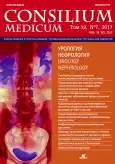Introduction. The prevalence of azoospermia in the population of all men is 1%, and among infertile men - 10-15%. The cause of azoospermia can be various clinical, endocrine, genetic and other factors. The purpose of the study: the identification of clinical, endocrine and genetic factors affecting the detection rate of spermatozoa with open testicular biopsy in patients with azoospermia. Patients and methods. 44 men with non-obstructive azoospermia aged from 20 to 55 years were examined. All patients had a wide range of instrumental, laboratory and physical methods of research before performing a testicular biopsy. In the blood plasma, the level of luteinizing (LH) and follicle-stimulating hormones (FSH), prolactin, total and free testosterone, estradiol, globulin, binding sex hormones was determined. Genetic tests included the study of the karyotype and the determination of the azoospermia factor. Results. In factor analysis, three factors were identified, that is, three sets of hormonal and clinical indicators that affect the outcome of an open testicular biopsy. It turned out that the explained variance reached 85%, and the individual significance of the third factor was highly informative. "Artificial neural network" allowed to reveal the factors influencing the frequency of detection of spermatozoa with open testicular biopsy. Conclusions. The outcome of testicular biopsy in patients with azoospermia is influenced by three groups of factors: the first - FSH and LH, the second - prolactin and age, the third - the age and total testosterone. The artificial neural network revealed the predictors of testicular sperm extraction (TESE) outcomes, which are a combination of clinical (the presence of an operation for varicocele in the past, the age of a patient older than 30 years), endocrine (high FSH), and genetic factors (Klinefelter syndrome, AZFc microdeletions).
 8-14
8-14


 15-19
15-19


 20-22
20-22


 23-27
23-27


 28-34
28-34


 35-40
35-40


 41-44
41-44


 45-49
45-49


 50-55
50-55


 56-59
56-59


 60-64
60-64


 65-69
65-69


 70-75
70-75


 76-82
76-82


 83-85
83-85


 86-88
86-88







